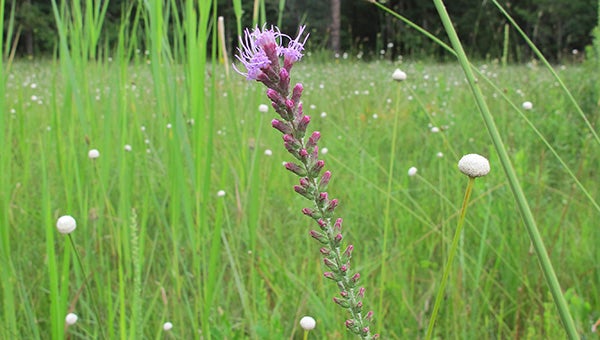Arboretum Paths: Use natives for garden combinations
Published 7:00 am Wednesday, July 29, 2015

Purple blazing star flower spikes have just begun to bloom in the Arboretum’s Savanna Exhibit (Photo by Jill Mirkovich
Last week, senior curator Jill Mirkovich brought in a collection photos she had just snapped in our Savanna Exhibit. In that collection was a wonderful surprise – the first long-awaited Liatris bloom had arrived.
Seasons come and go here in the savannas, and each one brings a new combination of color and texture. One year’s spring may look very different from the previous year, as plant colonies and individual plants create new patterns as their populations ebb and flow across the grasslands. Fall’s arrival is eagerly anticipated. Although we still have a while before we can truly say that autumn has arrived, the emergence of Liatris is a promise that it won’t be long.
Soon, a person standing in the South Pitcher Plant Bog will be surrounded by hundreds of blooming Liatris being visited by butterflies – including black and yellow swallowtails, and perhaps even a monarch or two. These tall purple spikes will stand tall against a backdrop of thousands upon thousands of pipewort (Eriocaulon), also known as lady’s hatpin or bog buttons, and yellow dashes of yellow-eyed grass (Xyris).
Liatris is commonly known as blazing star, or gayfeather. If you will search the Web for a photo for the species, Liatris spicata, currently blooming at the Arboretum, you may instantly recognize this perennial as one of the spiky components commonly used in floral arrangements. Or perhaps you have seen a glossy photo in a garden magazine, showing it in a garden bed and beautifully combined with native grasses and flowers such as purple coneflower (Echinacea) or black-eyed Susan (Rudbeckia).
I have noticed that black-eyed Susan, a native perennial species, is being used more frequently in commercial landscaping. Apparently its attractive, long-blooming, and low-maintenance qualities are being discovered and appreciated.
Former MSU Extension horticulturist Norman Winter, who once authored the “Southern Living” newspaper column, said that if you wanted your yard to look like it was designed by a landscape architect, just use a combination of a grass with a flat-topped flower such as Echinacea or Rudbeckia. Throw in some spikey blooms such as the Liatris, and you’re really in business!
Recently, a Facebook friend posted an awesome video of her Joe Pye weed covered in yellow swallowtail butterflies. This plant is occasionally spotted in local roadside ditches, but let me assure you that it has become an outstanding native perennial for the garden. Once known as Eupatorium purpureum, you will find that the Latin name is now Eutrochium purpureum.
Search for a photo of this plant, and picture Eupatorium’s lavender-pink blooms towering up to seven feet in the back of your perennial bed! Compact, shorter varieties are also available. The plant grows in full to part sun, and prefers rich soils that do not dry out.
Finally, consider including species of milkweed in your garden. Come by the Arboretum for a handout on Mississippi milkweed species that will do well in Pearl River County. There are other common and easily-grown species available as seed or plants in the trade, including whorled milkweed (Asclepias verticillata) and swamp milkweed (Asclepias perennis), which are included in this list, but the orange butterfly weed (Asclepias tuberosa) is by far the most well-known and widely available species.
Combine the perennials described here with a native grass such as pink muhly grass (Muhlenbergia capillaris) for a surefire formula for designing attractive, low-care perennial beds in your landscape. Celebrate late summer’s transition into fall by learning a lesson from the Crosby Arboretum’s exhibits that feature plant communities, not just individual plants.
Learn more about local wildflowers and native plants in a summer wildflower walk of the Arboretum onSaturday, August 8 from 10 to 11 a.m. The tour will focus on the south Savanna Exhibit and pitcher plant bog. Points of interest will be discussed along the journey, including ways to use native plants in your home landscape, and their value to wildlife. Bring your camera, and dress for walking. Admission is free for members and $5 for non-members.
The Arboretum is open Wednesdays through Sundays from 9 a.m. to 5 p.m. and located in Picayune, off I-59 Exit 4, at 370 Ridge Road (south of Walmart and adjacent to I-59). For more information about our programs and events, see the website at www.crosbyarboretum.msstate.edu.
FOR FURTHER EXPLORATION:
Do you miss reading former MSU Extension horticulturist Norman Winter’s weekly newspaper articles? Pay a visit to the Extension Service’s website at www.MSUcares.com and enter the keywords “Southern Gardening news features” to view archived columns going back to 1997 for Norman, and for the current host of Southern Gardening, Dr. Gary Bachman, associate Extension professor of horticulture at the Coastal Research and Extension Center in Biloxi.
By Patricia Drackett



